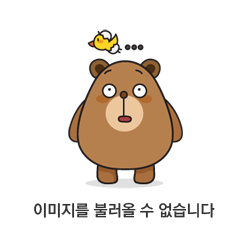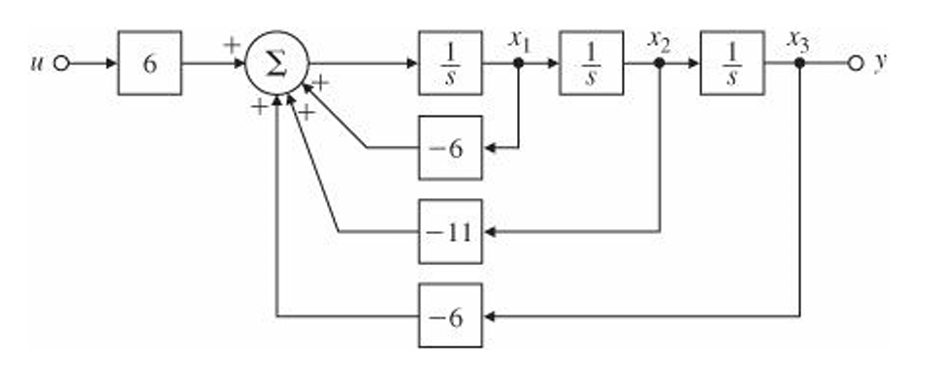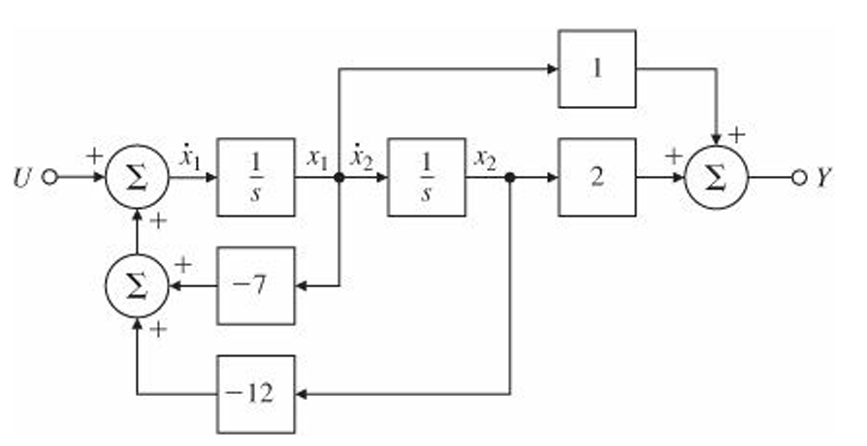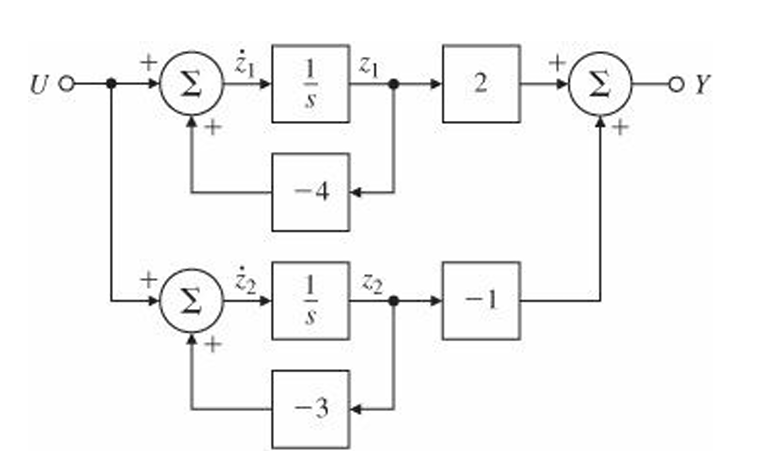feedback control system을 디자인하는 여러 방법 중 하나인 State-Space method를 다루도록 한다.
State-Space Design은 시스템의 state-variable을 직접 다루며 동적 보상을 설계하는 과정이다. 즉, 주어진 환경에서 목표로 하는 design specifications에 맞는 compensation D(s)를 찾는 것이 State-Space method의 역할이다.

The steps of the design method
1. Select closed-loop pole (root as referred to in previous chapters) locations and develop the control law for the closed-loop system that corresponds to satisfactory dynamic response
2. Design an estimator
3. Combine the control law and the estimator
4. Introduce the reference input
Advantages of State-Space
The differential equations describing a dynamic system are organized as a set of first-order differential equations in the vector-valued state of the system, and the solution is visualized as a trajectory of this state vector in space. ODEs of physical dynamic systems can be manipulated into state-variable form. In the field of Normal form mathematics, where ODEs are studied, the state-variable form is called the normal form for the equations.
System Description in State-Space
˙x=Fx+Guwherey=Hx+Ju
F:n×n,G:n×1,H:1×n,J:scalar
ex 7.1)
Dynamics: I¨θ=Fcd+MD
다음 위성 자세 제어 모델을 state-variable form으로 표현하자. 이때 input은 u=Fc이고 MD=0을 가정한다.
˙θ=ω,˙ω=dIFc

ddt[θω][0100][θω]+[0d/I]Fc
시스템의 output은 위성의 자세(y=θ)이므로,
y=[10][θω]+0⋅u
따라서 state-variable form에 대한 행렬은 다음과 같다.
F=[0100],G=[0d/I],H=[10],J=0
ex 7.2)
Dynamics: ¨x+bm˙x=um
˙x=v,˙v=−bmv+1mu

ddt[xv]=[010−b/m][xv]+[01/m]u
a) 시스템의 output을 position y=x1=x로 정하자.
y=[10][xv]
따라서 state-variable form에 대한 행렬은 다음과 같다.
F=[010−b/m],G=[01/m],H=[10],J=0
b) 시스템의 output을 velocity v=x2로 정하자.
다른 행렬은 동일하고 output matrix H만 달라지게 된다.
H=[01]
Step Response를 다음처럼 얻을 수 있다.
% MATLAB CODE %
F=[0 1;0 –0.05];
G=[0;0.001]; H=[0 1];
J = 0;
sys = ss(F, 500*G,H,J); % step gives unit step response, so 500*G gives u = 500 N.
step(sys); % plots the step response
Block Diagrams and State-Space
ex 7.7)
Let's find a state-variable description and the transfer function of the third-order system whose differential eqn is ⃛y+6¨y+11˙y+6y=6u

x1=¨y,x2=˙y,x3=y
˙x1=−6x1−11x2−6x3+6u
˙x2=x1
˙x3=x2

F=[−6−11−6100010],G=[600],H=[001],J=0
% yield the transfer function
[num,den] =ss2tf(F,G,H,J);
% convert state-variable realization to pole-zero form
[z,p,k] =ss2zp(F,G,H,J)
% convert numerator-denominator to pole-zero form
[z,p,k] =tf2zp(num,den)Y(s)U(s)=6s3+6s2+11s+6=6(s+1)(s+2)(s+3)
Time and Amplitude Scaling in State-Space
Time scaling with τ=ω0t:
dxdτ=1ω0Fx+1ω0Gu=F′x+G′u
Amplitude scaling:
replacing x with z=D−1xx where Dx is a diagonal matrix of scale factors
replacing u with v=D−1uu
Dx˙z=1ω0FDxz+1ω0GDuv
Then ˙z=1ω0D−1xFDxz+1ω0D−1xGDuv=F′z+G′v
Block Diagrams and Canonical Forms
다음 전달 함수를 갖는 시스템을 생각하자.
G(s)=b(s)a(s)=s+2s2+7s+12=2s+4+−1s+3
Control Canonical Form
˙x=Acx+Bcu,y=Ccx
b(s)의 근은 전달 함수의 zeros이고, a(s)의 근은 전달 함수의 poles이다.

block diagram으로부터 다음 관계식을 얻을 수 있다.
˙x1=−7x1−12x2+u,˙x2=x1y=x1+2x2
이로부터 control canonical form의 matrix를 구할 수 있다.
Ac=[−7−1210],Bc=[10],Cc=[12],Dc=0
b(s)의 계수인 1, 2가 Cc 행렬에 나타나고, a(s)에서 최고차항을 제외한 계수 7, 12가 Ac의 1열에 반대 부호로 나타난다.
따라서, 다음 전달 함수에 대한 Control Canonical Form은 아래와 같이 결정된다.
b(s)a(s)=b1sn−1+b2sn−2+⋯bnsn+a1sn−1+a2sn−2+⋯an
Ac=[−a1−a2⋯⋯−an10⋯⋯001⋯⋯0⋮⋱⋮⋮0⋯⋯10],Bc=[10⋮0],
Cc=[b1b2⋯bn],Dc=0
num = b = [b1 b2 ... bn ]
den = a = [1 a2 ... an]
[Ac, Bc, Cc, Dc] =tf2ss(num,den).
Modal Canonical Form
˙z=Amz+Bmu,y=Cmz+Dmu

Am=[−400−3],Bm=[11],Cm=[2−1],Dm=0
전달함수가 분수의 합으로 표현된 부분을 살펴보면 poles(-4, -3)이 Am 행렬의 대각선에 들어가 있고, 각 분수의 분자(2, -1)이 Cm에 나타난다.
canonical form으로 나타낼 때 맞닥뜨릴 수 있는 어려움이 두 가지 있다.
1) the elements of the matrices will be complex when the poles of the system are complex
express the complex poles of the partial-fraction expansion as conjugate pairs in second-order terms so that all the elements remain real. The corresponding Am matrix will then have 2 × 2 blocks along the main diagonal representing the local coupling between the variables of the complex-pole set.
2) the system matrix cannot be diagonal when the partial-fraction expansion has repeated poles
couple the corresponding state-variables, so that the poles appear along the diagonal with off-diagonal terms indicating the coupling.
ex) G(s)=1/s2
F=[0100],G=[01],H=[10],J=0
ex 7.9)
다음 전달 함수에 대한 modal form의 state matrices를 찾아보자
G(s)=2s+4s2(s2+2s+4)=1s2−1s2+2s+4

F=[0000100000−2−40010],G=[1010],
H=[010−1],J=0
'Study > Control' 카테고리의 다른 글
| Observability (0) | 2025.01.30 |
|---|---|
| Controllability (0) | 2025.01.30 |
| Frequency-Response Design (0) | 2025.01.15 |
| Root Locus, Compensation (0) | 2025.01.13 |
| PID Control (1) | 2025.01.04 |